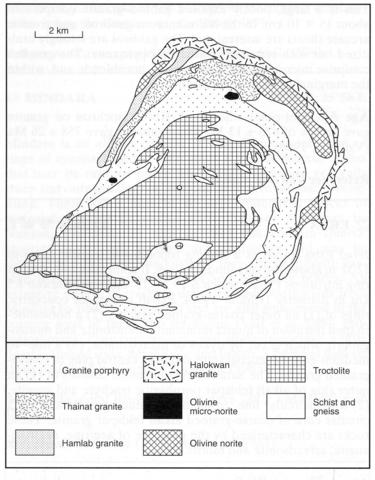stripes
A pear-shaped complex of 16x11 km Tehilla is emplaced in Precambrian greenschists and consists of an early basic suite which was followed by a series of arcuate granites. The basic rocks comprise a core troctolite and two crescentic bodies of norite. Both rock types are composed dominantly of plagioclase, olivine and bronzite with abundant opaques that locally form segregations of ilmenite-titanomagnetite. These were slightly thermally metamorphosed by later granites the five units of which (Ahmed, 1977a) were emplaced from the outside inwards. Xenoliths and rafts of country rocks are abundant in all units. All the granites consist of some 90% perthite plus quartz while hastingsite is also universal; a little aegirine-augite occurs in the Halokwan, Hamlamb and Thainat granites. Doleritic and granitic dykes are plentiful within the intrusion and country rocks. Chemical and modal analyses of each of the main rock types are given by Ahmed (1977a). An areal photograph of Tehilla is in Delaney (1955).
AHMED, F. 1977a. Petrology and evolution of the Tehilla igneous complex, Sudan. Journal of Geology, 85: 331-43.ALI, S.E.M. 1979. The geology of the Homogar Group volcanic rocks, southern Red Sea Hills, Sudan. M.Phil. thesis, Portsmouth Polytechni U.K. 163 pp. (unpublished)DELANEY, F.M. 1955. Ring structures in the northern Sudan. Eclogae Geologicae Helvetiae, 48: 133-48.KLEMENIC, P.M. 1983. Isotope geology and geochemistry of selected igneous complexes and basement rocks in north-east Sudan. Ph.D. thesis, Portsmouth Polytechnic. 385 pp. (unpublished).VAIL. J.R. 1978. Outline of the geology and mineral deposits of the Democratic Republic of the Sudan and adjacent areas. Overseas Geology and Mineral Resources, Institute of Geological Sciences, 49: 1-66.VAIL, J.R. and REX, D.C. 1970. Tectonic and geochronological studies in Sudan. Annual Report, Research Institute of African Geology, University of Leeds, 14: 44-7.

